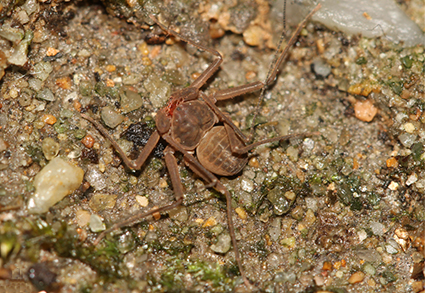Abstract
To date, only two whip spider species have been recorded in China. We describe a new species, Sarax sinensis sp. nov., from Fujian, China. This species is morphologically similar to S. ioanniticus (Kritscher, 1959), S. israelensis (Miranda et al., 2016), and S. seychellarum (Kraepelin, 1898), but can be distinguished by the combination of the following characters: 35 segments in leg I tarsus, eight teeth on cheliceral claw, and four dorsal and ventral spines respectively on pedipalp femur. To examine the evolutionary history of S. sinensis sp. nov., we sequenced 12S, 16S, and COI gene regions of our specimens and inferred its phylogenetic position. The inferred phylogenetic trees placed the new species within Sarax, with its closest relative being distributed across the western Asia. The type specimens are deposited in the Museum of Biology, East China Normal University (ECNU).
References
Arabi, J., Cruaud, C., Couloux, A. & Hassanin, A. (2010) Studying Sources of Incongruence in Arthropod Molecular Phylogenies: Sea Spiders (Pycnogonida) as a Case Study. Comptes Rendus Biologies, 333 (5), 438–453. https://doi.org/10.1016/j.crvi.2010.01.018
Badgley, C., Smiley, T., Terry, R., Davis, E., DeSantis, L. & Fox, D. (2017) Biodiversity and Topographic Complexity: Modern and Geohistorical Perspectives. Trends in Ecology & Evolution, 32 (3), 211–226. https://doi.org/10.1016/j.tree.2016.12.010
Foelix, R.F. & Hebets, E.A. (2001) Sensory Biology of Whip Spiders (Arachnida, Amblypygi). Andrias, 15, 129–140.
Garwood, R.J., Dunlop, J.A., Knecht, B.J. & Hegna, T.A. (2017) The Phylogeny of Fossil Whip Spiders. BMC Evolutionary Biology, 17 (1), 1–14. https://doi.org/10.1186/s12862-017-0931-1
Giupponi, A. & Kury, A. (2013) Two New Species of Heterophrynus Pocock, 1894 from Colombia with Distribution Notes and a New Synonymy (Arachnida: Amblypygi: Phrynidae). Zootaxa, 3647 (2), 329–342. https://doi.org/10.11646/zootaxa.3647.2.5
Harvey, M.S. & West, P.L.J. (1998) New Species of Charon (Amblypygi, Charontidae) from Northern Australia and Christmas Island. Journal of Arachnology, 26, 273–284.
Heath, B. & Richard, H.A. (2015) evobiR: Comparative and Population Genetic Analyses. R Package Version 1.1. [program]
Huelsenbeck, J.P. & Ronquist, F. (2001) MRBAYES: Bayesian Inference of Phylogenetic Trees. Bioinformatics, 17 (8), 754–755. https://doi.org/10.1093/bioinformatics/17.8.754
Kalyaanamoorthy, S., Minh, B., Wong, T.K.F., von Haeseler, A. & Jermiin, L.S. (2017) ModelFinder: Fast Model Selection for Accurate Phylogenetic Estimates. Nature Methods, 14(6), 587–589. https://doi.org/10.1038/nmeth.4285
Katoh, K. & Standley, D.M. (2013) MAFFT Multiple Sequence Alignment Software Version 7: Improvements in Performance and Usability. Molecular Biology and Evolution, 30 (4), 772–780. https://doi.org/10.1093/molbev/mst010
Kocher, T.D., Thomas, W.K., Meyer, A., Edwards, S.V., Pääbo, S., Villablanca, F.X. & Wilson, A.C. (1989) Dynamics of Mitochondrial DNA Evolution in Animals: Amplification and Sequencing with Conserved Primers. Proceedings of the National Academy of Sciences, 86 (16), 6196–6200. https://doi.org/10.1073/pnas.86.16.6196
Minh, B.Q., Schmidt, H.A., Chernomor, O., Schrempf, D., Woodhams, M.D., Von Haeseler, A. & Lanfear, R. (2020) IQ-TREE 2: New Models and Efficient Methods for Phylogenetic Inference in the Genomic Era. Molecular Biology and Evolution, 37 (5), 1530–1534. https://doi.org/10.1093/molbev/msaa015
Miranda, G., Giupponi, A., Prendini, L. & Scharff, N. (2018) Weygoldtia, a new Genus of Charinidae Quintero, 1986 (Arachnida, Amblypygi) with a Reappraisal of the Genera in the Family. Zoologischer Anzeiger, 273, 23–32. https://doi.org/10.1016/j.jcz.2018.02.003
Miranda, G. & Reboleira, A. (2019) Amblypygids of Timor-Leste: First Records of the Order from the Country with the Description of a Remarkable New Species of Sarax (Arachnida, Amblypygi, Charinidae). Zookeys, 820, 1–12. https://doi.org/10.3897/zookeys.820.30139
Miranda, G.S., Giupponi, A.P., Scharff, N. & Prendini, L. (2021a) Phylogeny and Biogeography of the Pantropical Whip Spider Family Charinidae (Arachnida: Amblypygi). Zoological Journal of the Linnean Society, 194 (1), 136–180. https://doi.org/10.1093/zoolinnean/zlaa101
Miranda, G.S., Giupponi, A.P., Prendini, L. & Scharff, N. (2021b) Systematic Revision of Charinidae Quintero, 1986 (Arachnida, Amblypygi). European Journal of Taxonomy, 772, 1–409. https://doi.org/10.5852/ejt.2021.772.1505
Rahmadi, C., Harvey, M.S. & Kojima, J. (2010) Whip Spiders of the Genus Sarax Simon 1892 (Amblypygi: Charinidae) from Borneo Island. Zootaxa, 2612 (1), 1–21. https://doi.org/10.11646/zootaxa.2612.1.1
Reveillion, F. & Pierre-Olivier, M. (2018) A New Species of Charon (Amblypygi: Charontidae) from Orchid Island (Taiwan). Revista Ibérica de Aracnología, 32, 31–36.
Seiter, M., Wolff, J. & Hörweg, C. (2015) A New Species of the South East Asian Genus Sarax Simon, 1892 (Arachnida: Amblypygi: Charinidae) and Synonymization of Sarax mediterraneus Delle Cave, 1986. Zootaxa, 4012 (3), 542–552. https://doi.org/10.11646/zootaxa.4012.3.8
Simon, C., Frati, F., Beckenbach, A., Crespi, B., Liu, H. & Flook, P. (1994) Evolution, Weighting, and Phylogenetic Utility of Mitochondrial Gene Sequences and a Compilation of Conserved Polymerase Chain Reaction Primers. Annals of the Entomological Society of America, 87 (6), 651–701. https://doi.org/10.1093/aesa/87.6.651
Trifinopoulos, J., Nguyen, L.T., von Haeseler, A. & Minh, B.Q. (2016) W-IQ-TREE: a Fast Online Phylogenetic Tool for Maximum Likelihood Analysis. Nucleic Acids Research, 44 (W1), W232–W235. https://doi.org/10.1093/nar/gkw256
Weygoldt, P. (2000) Whip Spiders (Chelicerata: Amblypygi). Their Biology, Morphology and Systematics. Apollo Books, Stenstrup, 163 pp.
Wolff, J.O., Seiter, M. & Gorb, S.N. (2015) Functional Anatomy of the Pretarsus in Whip Spiders (Arachnida, Amblypygi). Arthropod Structure & Development, 44, 524–540. https://doi.org/10.1016/j.asd.2015.08.014
Zhu, X., Wu, S., Liu, Y., Reardon, C., Roman-Palacios., C., Li, Z. & He, Z. (2021) A New Species of Whip Spider, Weygoldtia hainanensis sp. nov., from Hainan, China (Arachnida: Amblypygi: Charinidae). Zootaxa, 5082 (1), 65–76. https://doi.org/10.11646/zootaxa.5082.1.6


